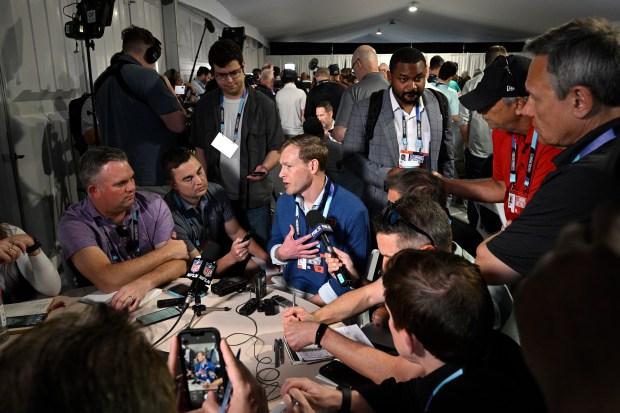PALM BEACH, Fla. — The NFL owners meetings wrapped up Wednesday at The Breakers resort, a three-day affair in which the league got to the bottom — or in the case of the spirited “tush push” debate, right to the middle — of several pressing issues.
Rules revisions were made, most notably a tweak to last season’s dynamic kickoff experiment in which touchbacks now will be moved out to the 35-yard line instead of the 30.
Technological advancements were announced, with Sony’s Hawk-Eye Virtual Measurement System selected to assist with first-down measurements.
For the Chicago Bears, the week also offered an opportunity to further articulate their vision for everything that’s ahead. Team leaders spoke openly on everything from the stadium project to this month’s NFL draft planning to the relationships that new coach Ben Johnson is building as he gets settled.
With the Bears beginning Phase 1 of their offseason program Monday in Lake Forest and sprinting into the home stretch of their draft preparation, here are four observations from the week in Florida.
1. Ben Johnson has a sneaky competitive edge to him. Chicago should love it.
Johnson got a chuckle during his introductory news conference in January when, while discussing his eagerness to challenge himself in a stacked NFC North, he fired off a stray.
“I have a tremendous amount of respect for the coaches and players in this (division),” he said. “I’ve been competing against them for the last six years. Dan Campbell, Kevin O’Connell — talk about two guys who are up for Coach of the Year awards as the season ends here. And to be quite frank with you, I kind of enjoyed beating Matt LaFleur twice a year.”
That may have seemed like a playful throwaway line, a little gibe-with-a-smile to pander to Bears fans by poking at the rival Green Bay Packers. But don’t underestimate Johnson’s bite, his willingness to stir the pot and his fearlessness to, almost in a scampish way, kick at the hornet’s nest for sport.
On Tuesday at the NFC coaches breakfast, LaFleur was asked about Johnson’s January quip and predictably shrugged it off.
“It’s all good,” he said. “I’m sure he’s playing with the fans a little bit. It is what it is. I’m not going to lose too much sleep over it.”
But privately, LaFleur had expressed at least some confusion and agitation that Johnson singled him out by name and, given their lack of any real relationship, had the boldness to puff his chest so publicly about his success in their head-to-head matchups.
In other words, the jab landed.
Let the record reflect that LeFleur owns a .670 winning percentage during six seasons as the Packers coach and has led the team to five playoff appearances and three NFC North titles. Johnson and the Bears definitely have some catching up to do.
But let the record also reflect that Johnson’s Detroit Lions swept the Packers last season — 24-14 in Week 9 and 34-31 five weeks later — and went 3-1 in the series over the previous two seasons with Johnson calling plays for the Lions offense.
The flames of the Bears-Packers rivalry haven’t had much crackle to them in years. Green Bay has won 75% of the meetings this century and 28 of the last 33 games.
Johnson, though, has shown an unapologetic willingness to splash a few drops of kerosene. And he described his interactions with LaFleur this week with a wry smile, noting that the two exchanged a “cordial handshake” but not much more. The NFL’s schedule release can’t come soon enough.
Johnson, without question a self-assured, Type A leader, doesn’t shy away from a little competitive friction. When I asked him Monday morning if it was fair to say that he has a little bit of, um, competitive nastiness to him, his wide smile was telling.
“Yeah,” he said. “We all do.”
That, Johnson said, is part of what makes life worth living, what makes coaching such a passion pursuit for him.
“It’s part of the reason we got into this in the first place,” he said. “It’s to help the players become better themselves.
“But also, I think once you leave the locker room and the camaraderie and the competition (as a player), you miss it. That was clear my first year out of football, when I was done playing. It didn’t take me but 12 months to realize that, no, I need to be back in this and do whatever I can to stay in it.”
General manager Ryan Poles admitted to being both impressed and amused by that prodding competitive spirit Johnson has shown. When the Bears began their coaching search, Poles had a different impression of Johnson in his head, viewing him from afar as a brainy offensive mastermind who seemed a bit reserved.
“It’s funny,” Poles said. “When you scout players, you’re always asking, ‘Will you have to push this player or do you have to pull them back?’ And the narrative (on Johnson) made me feel like he was going to have to be pushed.
“But the truth is, he’s probably going to have to be pulled back more than than anything. Just because of the fire he has and the competitive attitude that he brings. It’s outstanding.”
Johnson won’t apologize for his edge — or the subtle shot at LaFleur. And Poles doesn’t want him to soften that side of himself.
“That’s the mentality we’re asking our players to have,” Poles said. “So now having a head coach and a coaching staff that thinks that way and prepares that way is going to be fun.”
2. An urgent, high-stakes experiment is about to start for QB Caleb Williams.
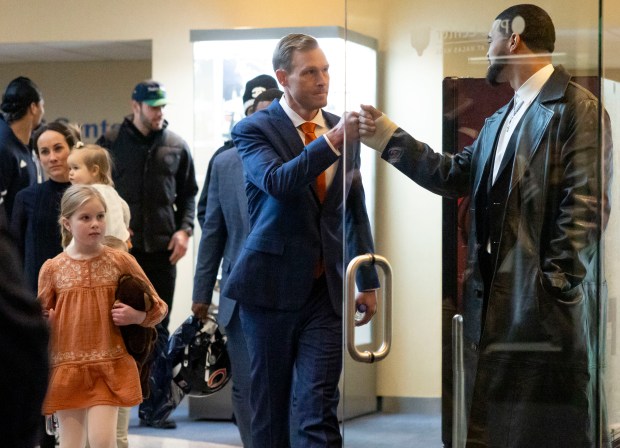
As Williams gets to know his new coach and play caller, and as he and Johnson work to build rapport and trust during the offseason program, there will be an immediate push to test the quarterback’s comfort working under center.
As a rookie, Williams took more than 70% of his snaps out of the shotgun formation, building on the comfort he established there at USC, Oklahoma and Gonzaga College High School in Washington, D.C.
Johnson’s initial vision for his offense, however, is to have the Bears become much more reliant on under-center formations and concepts. He hopes that modification will first stimulate the running game and by extension create more play-action opportunities for Williams and the passing attack.
“I’m more prone to the play-action game from underneath (center),” Johnson said, “because I do think the longer action, the longer fake, does tend to hold the second level (of a defense) for a little bit longer. That’s where you get your chunks and your shots behind them.”
Will it click immediately for Williams? At all? Who knows?
But Johnson is determined to push the issue during the spring, encouraging Williams to step outside of his comfort zone while not being stubborn to force the issue if it’s not working out.
“It’s time on task,” Johnson said. “It’s about how many reps can we get under his belt where he feels better and better about taking drops under center. … There is merit for looking to develop that part of his game.
“The truth is, even if we do invest and we ultimately decide that’s not the direction we want to go too far in, it’s still really worthwhile for him to have that time on task. Because it’s going to translate to the shotgun as well.”
In January, Johnson highlighted his belief that quarterback performance is the No. 1 driving force that determines winning and losing in today’s NFL. Asked Monday which metric he values most in assessing quality quarterback play, Johnson immediately cited “EPA.”
That’s expected points added, an analytics tool that measures how each play in a series affects a team’s likelihood to score on that possession.
It’s a nuanced and somewhat complex calculation that takes into account, among other things, the down and distance of each play, the spot on the field where the play begins and the team’s scoring probability both before and after the play.
Last season, according to ESPN Analytics, Williams ranked 20th among quarterbacks in EPA at 50.4. The top five were Joe Burrow (122.6), Lamar Jackson (107.9), Josh Allen (101.0), Jayden Daniels (98.4) and Patrick Mahomes (98.3).
All of those quarterbacks except Burrow reached the postseason. So did Johnson’s quarterback in Detroit, Jared Goff, who ranked 10th at 75.5.
There will be a crash course in Chicago to study the EPA concept more closely. Johnson was emphatic in citing that metric as the one he’s most wedded to, noting a victory rate of about 80% for the team that registers the higher passing game EPA.
“It’s a huge stat,” Johnson said. “That’s where we look and say, ‘How do we help inflate that number?’ (It’s) higher completion percentage. More run-after-the-catch opportunities.”
That likely means more shorter passes for Williams. And it means schooling him on the best ways to enhance his EPA.
3. Caleb Williams’ introductions at Halas Hall have only just begun.
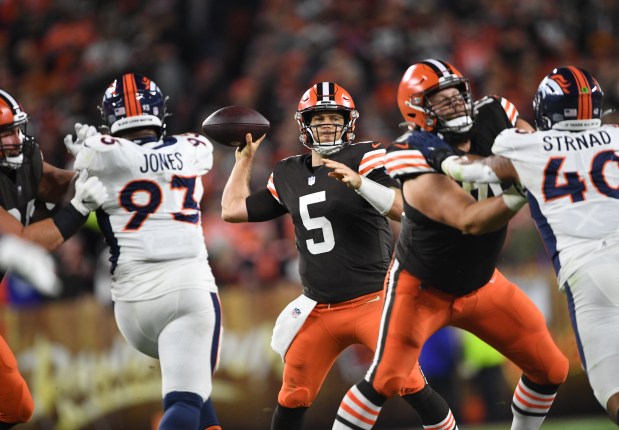
When the Bears quarterback reports back to work Monday, his relationship-building efforts will extend far beyond Johnson. He’ll have to quickly get to know new quarterbacks coach J.T. Barrett, offensive coordinator Declan Doyle and passing game coordinator Press Taylor.
He’ll also have a new veteran tutor in the quarterbacks room with the Bears agreeing to terms Thursday with 37-year-old Case Keenum. The move strengthens the position group’s developmental dynamics in what figures to be a pivotal year for Williams.
As a rookie, Williams shared the quarterbacks room with backup Tyson Bagent and third-stringer Austin Reed. Bagent, who turned 24 last summer, was in only his second season after joining the Bears as an undrafted free agent out of Division II Shepherd. Reed had a similar arrival, joining the team in 2024 as a college free agent out of Western Kentucky.
That didn’t leave the Bears with a deep library of experience in their most important position room. The idea of having seventh-year veteran Brett Rypien lend some veteran support and oversight to Williams fizzled in August when Rypien turned his strong preseason with the Bears into an opportunity to join the Minnesota Vikings’ 53-man roster.
Poles and coach Matt Eberflus also had hired recently retired quarterback Ryan Griffin as an offensive assistant last offseason, hoping he could provide additional guidance to Williams. But there has been an acknowledgment this year that Williams could use more of a direct peer presence, particularly when his coaches are pulled in different directions.
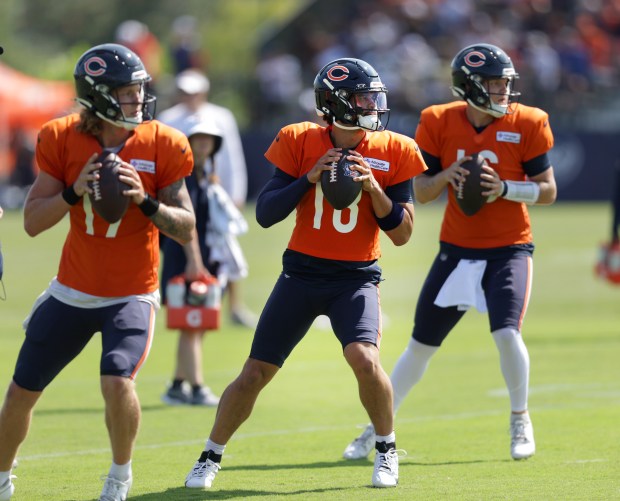
Enter Keenum, who can add wisdom to the developmental process.
“The dynamic in that room between coaches and players has to be outstanding, borderline elite,” Poles told the Tribune this week. “That’s in terms of how they communicate, how many people are communicating, et cetera.
“The relationship between the group is really important. With your backup quarterbacks, you want them competitive. You want them to be fighting for their opportunity. But at the same time they can’t be back-stabbing in order to move up the totem pole or to manipulate a situation. So there really should be no ego. At the same time you want to stay competitive and stay ready for your opportunity.
“It’s a very interesting room. But it’s a room that has to be right.”
Thursday’s move was an attempt to make it so.
Keenum’s 13 seasons in the NFL have taken him through seven organizations, including two stints with the Houston Texans, where he spent the past two years alongside C.J. Stroud, who was named Rookie of the Year in 2023.
Keenum’s most memorable season playing came in 2017 in Minnesota when he became the Vikings starter over Teddy Bridgewater, who was still enduring a lengthy recovery from a dislocated knee. Keenum won 11 of his 14 regular starts that year, threw for 3,547 yards and 22 touchdowns and authored one of the most incredible playoff finishes in league history with a walk-off 61-yard touchdown pass to Stefon Diggs as time expired to beat the New Orleans Saints in “The Minneapolis Miracle.”
Still, his arrival at Halas Hall comes with the expectation that he will settle into a QB3 role as a key resource and guide for Williams. The Bears initial vision is for Bagent to retain backup duties. But the hope is that Keenum’s experience and wisdom can become a valuable behind-the-scenes asset.
4. Accountability. Accountability. Accountability.
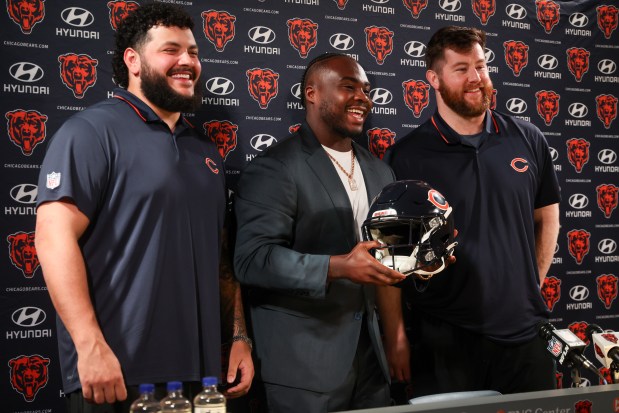
That was such a prominent buzzword in the Halas Hall locker room last season, with Bears players pleading for much more of it during their maddening 10-game losing streak and seeking ways to increase it.
Poles followed at season’s end by emphasizing that his search for Eberflus’ successor would hinge, at least partially, on finding a coach who could establish greater accountability within the team — and across the entire building.
Enter Johnson, who addressed that topic during his introductory news conference.
“Accountability means we’re going to do what we say we’re going to do and we’re going to be who we say we’re going to be,” he said. “And if we fall short of that standard, then there has to be consequences to that.”
Circle “consequences” as the keyword from that description. Now keep an eye on how effective Johnson is in turning that philosophy into action.
He reiterated Tuesday morning he has every intention of coaching this team hard and believes he has assembled a staff to help establish defined standards and enforce them.
A few hours later, Poles hit the topic of accountability head on.
“It’s just being able to call out the things that aren’t up to standard right there in the moment,” he said. “Man to man. And sometimes it’s in a group setting, like, ‘This isn’t how he wants it.’ And you address it immediately.
“I think that is something Ben is going to be really good at. And we’ll do that together across all spaces of football. It’s something we’ve talked about a lot and something I feel confident our guys are going to feel.”
Coming out of the 2024 season, Poles insinuated the Bears’ player-driven leadership needed a boost, even after last year’s team elected eight captains to guide it.
As fond as Poles was of that group — seven of whom remain on the roster — he noted that designated leaders sometimes need to be shown and taught how to lead properly.
Poles is celebrating the arrival of veteran linemen Joe Thuney and Grady Jarrett, believing they can have a positive impact in that regard.
“That is the added bonus of bringing those guys in,” Poles said, “because they can show (others) how to do it. I always think it’s important that, in order to lead, you also have to be taking care of business on the field and being productive. I’ve seen situations where there are older guys who aren’t really in their prime and they’re almost in survival mode trying to finish out their career, and it just doesn’t hold as much weight.
“But when a guy is playing at a high level and has won a bunch of games? I think it’s weighted heavier. Guys will follow and listen to players like that.”
Johnson said he plans to have at least three captains and a maximum of five. And at the top of his list of assistant coaches who can help set, maintain and enforce standards are running backs coach Eric Bieniemy, wide receivers coach/assistant head coach Antwaan Randle El and defensive backs coach Al Harris.
“We’re going to hear them vocally once we get out on the field,” Johnson said.


